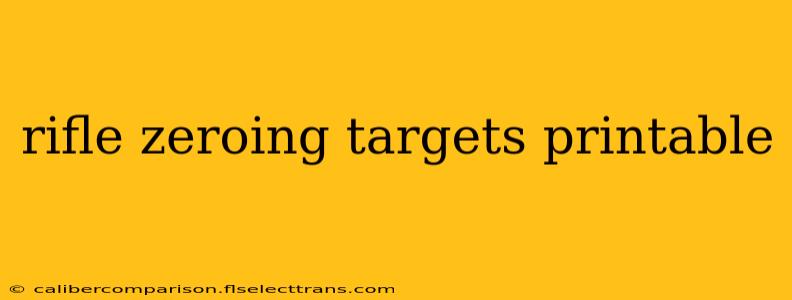Achieving accurate shot placement with your rifle requires proper zeroing. This process involves adjusting your sights (or scope) to ensure your bullet impacts precisely where you aim at a specific distance. Utilizing a high-quality zeroing target is crucial for this process. This guide explores various printable rifle zeroing targets and how to effectively use them to achieve optimal accuracy.
Understanding Rifle Zeroing
Before diving into printable targets, let's briefly review the fundamentals of rifle zeroing. The goal is to establish a consistent point of impact (POI) at a specific range, often 25, 50, or 100 yards (or meters). This zeroing distance is chosen based on your rifle's intended use, with shorter ranges suitable for closer-range shooting and longer ranges for hunting or target shooting at greater distances.
The process typically involves:
- Establishing a stable shooting position: Use a rest or benchrest to minimize movement.
- Firing a group of shots: Fire three to five shots at your chosen zeroing distance.
- Analyzing the group: Examine the shot group to determine the vertical and horizontal adjustments needed.
- Adjusting the sights or scope: Make appropriate adjustments based on your findings, using the appropriate tools for your firearm.
- Repeating the process: Continue firing and adjusting until the POI aligns with the point of aim.
Types of Printable Rifle Zeroing Targets
Various printable target designs cater to different needs and preferences. Here are a few popular options:
1. Simple Bullseye Targets
These are the most basic targets, featuring a central bullseye and concentric circles. They are ideal for beginners and provide a clear indication of shot grouping. Their simplicity makes them easy to print and use. You can easily find numerous variations online, ranging from small, close-up targets to larger targets for longer distances. Look for targets that include measurements in both inches and centimeters for flexibility.
2. Mil-Dot Targets
Mil-dot targets incorporate mil-dots, which are small dots arranged in a specific pattern. These dots help in estimating range and bullet drop compensation, particularly useful for longer-range shooting. While more complex, they offer superior information for advanced shooters. Using a mil-dot scope and a corresponding target will assist in calculating trajectory adjustments efficiently.
3. Gridded Targets
Gridded targets feature a grid of squares, allowing for precise measurement of shot placement. This detailed information aids in determining not only the vertical and horizontal deviation but also the consistency of your shooting. The grid structure provides a framework for detailed shot analysis.
4. Combination Targets
Combining elements from the above types—bullseye, mil-dot, and gridded components—creates a versatile target useful for various stages of zeroing and shooter skill levels. These targets cater to a wider range of shooting needs in a single printable design.
Tips for Printing and Using Your Targets
- Paper Choice: Use a sturdy paper or card stock to prevent tearing or damage during shooting.
- Ink Quality: Ensure your printer uses a high-quality ink to produce clear and durable targets.
- Target Size: Select an appropriately sized target for your zeroing distance.
- Safe Handling: Always follow safe gun handling procedures. Never point a firearm at anything you don't intend to shoot.
- Consistent Shooting: Maintain a consistent shooting position and technique for accurate results.
By utilizing printable rifle zeroing targets effectively, you can significantly improve the accuracy of your firearm. Remember, practice and patience are key to mastering the art of zeroing and achieving optimal shot placement. Selecting the right type of target based on your skill level and the information you need will significantly improve your zeroing efficiency and lead to more satisfying shooting experiences.

